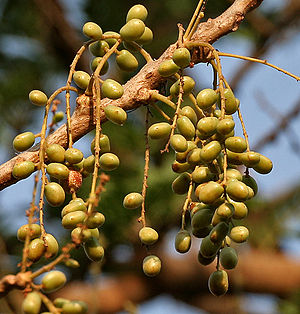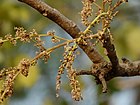Note: This is a project under development. The articles on this wiki are just being initiated and broadly incomplete. You can Help creating new pages.
Difference between revisions of "Lannea coromandelica - Jhingini"
(→Uses) |
|||
| Line 1: | Line 1: | ||
[[File:Lannea coromandelica (Wodier Tree) fruits in Hyderabd W IMG 7389.jpg|thumb|right|''Jhingini'', ''Lannea coromandelica'']] | [[File:Lannea coromandelica (Wodier Tree) fruits in Hyderabd W IMG 7389.jpg|thumb|right|''Jhingini'', ''Lannea coromandelica'']] | ||
| − | '''Jhingini''' is a deciduous tree usually growing 5 - 10 metres tall but with some specimens up to 20 metres tall with a bole 45cm in diameter. The leaves are gathered from the wild for local use as food and medicine. The plant is also cultivated in some areas of the tropics as a hedge plant and roadside tree | + | '''Jhingini''' is a deciduous tree usually growing 5 - 10 metres tall but with some specimens up to 20 metres tall with a bole 45cm in diameter. The leaves are gathered from the wild for local use as food and medicine. The plant is also cultivated in some areas of the tropics as a hedge plant and roadside tree. |
| − | |||
==Uses== | ==Uses== | ||
{{Uses|Sprains}}, {{Uses|Inflammation}}, {{Uses|Cuts}}, {{Uses|Burns}}, {{Uses|Dysentery}} | {{Uses|Sprains}}, {{Uses|Inflammation}}, {{Uses|Cuts}}, {{Uses|Burns}}, {{Uses|Dysentery}} | ||
| Line 11: | Line 10: | ||
==Common names== | ==Common names== | ||
| − | {{Common names|kn= | + | {{Common names|kn=Ajashringi, Goddi mara, Dhumpaarikuratike|ml=Kalasu, Kalesjam, Karasu, Karayam, Otiyamaram, Thingam|sa=Ajasringgi, Jhingini, Gudamanjari, Netrashuddhi, Jhingi, Jivala, Kvala, Manjari|ta=Anaikarai, Vodiyar, Odiya-maram, Odiyan|te=Goompana chettu, Gumpena, Oddimanu, Dhumpari|hi=Jhingan, Kashmal|en=Indian ash tree}} |
<ref name="Common names"/> | <ref name="Common names"/> | ||
| Line 35: | Line 34: | ||
==Identification== | ==Identification== | ||
===Leaf=== | ===Leaf=== | ||
| − | {{Leaf|Pinnate| | + | {{Leaf|Pinnate|Alternate|Leaves bipinnate, alternate, stipulate, rachis 14.5-62.5 cm long, stout, with a gland at the tip. Pinnae 2-3 pairs, leaflets 8-20.}}<ref name="Leaf"/> |
===Flower=== | ===Flower=== | ||
| − | {{Flower|Axillary | | + | {{Flower|Axillary |Axillary or terminal racemes|Yellowish green|8|male flowers : in compound racemes, 8 mm across; calyx 4-lobed; lobes ovate, imbricate, persistent.}} |
===Fruit=== | ===Fruit=== | ||
| − | {{Fruit|A drupe|12 mm long|| | + | {{Fruit|A drupe|12 mm long||Ovoid, red; stone hard; seed compressed|}} |
===Other features=== | ===Other features=== | ||
| Line 53: | Line 52: | ||
==How to plant/cultivate== | ==How to plant/cultivate== | ||
| − | |||
Seed - it has a short viability and so needs to be sown as soon as possible. | Seed - it has a short viability and so needs to be sown as soon as possible. | ||
Cuttings - very easy, even large branches usually root | Cuttings - very easy, even large branches usually root | ||
Revision as of 17:53, 29 May 2020
Jhingini is a deciduous tree usually growing 5 - 10 metres tall but with some specimens up to 20 metres tall with a bole 45cm in diameter. The leaves are gathered from the wild for local use as food and medicine. The plant is also cultivated in some areas of the tropics as a hedge plant and roadside tree.
Contents
- 1 Uses
- 2 Parts Used
- 3 Chemical Composition
- 4 Common names
- 5 Properties
- 6 Habit
- 7 Identification
- 8 List of Ayurvedic medicine in which the herb is used
- 9 Where to get the saplings
- 10 Mode of Propagation
- 11 How to plant/cultivate
- 12 Commonly seen growing in areas
- 13 Photo Gallery
- 14 References
- 15 External Links
Uses
Sprains, Inflammation, Cuts, Burns, Dysentery [1]
Parts Used
Chemical Composition
Common names
| Language | Common name |
|---|---|
| Kannada | Ajashringi, Goddi mara, Dhumpaarikuratike |
| Hindi | Jhingan, Kashmal |
| Malayalam | Kalasu, Kalesjam, Karasu, Karayam, Otiyamaram, Thingam |
| Tamil | Anaikarai, Vodiyar, Odiya-maram, Odiyan |
| Telugu | Goompana chettu, Gumpena, Oddimanu, Dhumpari |
| Marathi | NA |
| Gujarathi | NA |
| Punjabi | NA |
| Kashmiri | NA |
| Sanskrit | Ajasringgi, Jhingini, Gudamanjari, Netrashuddhi, Jhingi, Jivala, Kvala, Manjari |
| English | Indian ash tree |
Properties
Reference: Dravya - Substance, Rasa - Taste, Guna - Qualities, Veerya - Potency, Vipaka - Post-digesion effect, Karma - Pharmacological activity, Prabhava - Therepeutics.
Dravya
Rasa
Guna
Veerya
Vipaka
Karma
Prabhava
Habit
Identification
Leaf
| Kind | Shape | Feature |
|---|---|---|
| Pinnate | Alternate | Leaves bipinnate, alternate, stipulate, rachis 14.5-62.5 cm long, stout, with a gland at the tip. Pinnae 2-3 pairs, leaflets 8-20. |
Flower
| Type | Size | Color and composition | Stamen | More information |
|---|---|---|---|---|
| Axillary | Axillary or terminal racemes | Yellowish green | 8 | male flowers : in compound racemes, 8 mm across; calyx 4-lobed; lobes ovate, imbricate, persistent. |
Fruit
| Type | Size | Mass | Appearance | Seeds | More information |
|---|---|---|---|---|---|
| A drupe | 12 mm long | Ovoid, red; stone hard; seed compressed | {{{6}}} |
Other features
List of Ayurvedic medicine in which the herb is used
Where to get the saplings
Mode of Propagation
How to plant/cultivate
Seed - it has a short viability and so needs to be sown as soon as possible. Cuttings - very easy, even large branches usually root [4]
Commonly seen growing in areas
Tropical area, Sub tropical area
Photo Gallery
References
External Links
- [tropical.theferns.info/viewtropical.php?id=Lannea+coromandelica]
- [1]
- Ayurvedic Herbs known to be helpful to treat Sprains
- Ayurvedic Herbs known to be helpful to treat Inflammation
- Ayurvedic Herbs known to be helpful to treat Cuts
- Ayurvedic Herbs known to be helpful to treat Burns
- Ayurvedic Herbs known to be helpful to treat Dysentery
- Herbs with Bark used in medicine
- Herbs with Leaves used in medicine
- Herbs with common name in Kannada
- Herbs with common name in Hindi
- Herbs with common name in Malayalam
- Herbs with common name in Tamil
- Herbs with common name in Telugu
- Herbs with common name in Sanskrit
- Herbs with common name in English
- Habit - Tree
- Index of Plants which can be propagated by Seeds
- Index of Plants which can be propagated by Cuttings
- Herbs that are commonly seen in the region of Tropical area
- Herbs that are commonly seen in the region of Sub tropical area
- Herbs
- Plants of western ghats
- Anacardiaceae
- Ayurvedic herbs that don't have seed photos





